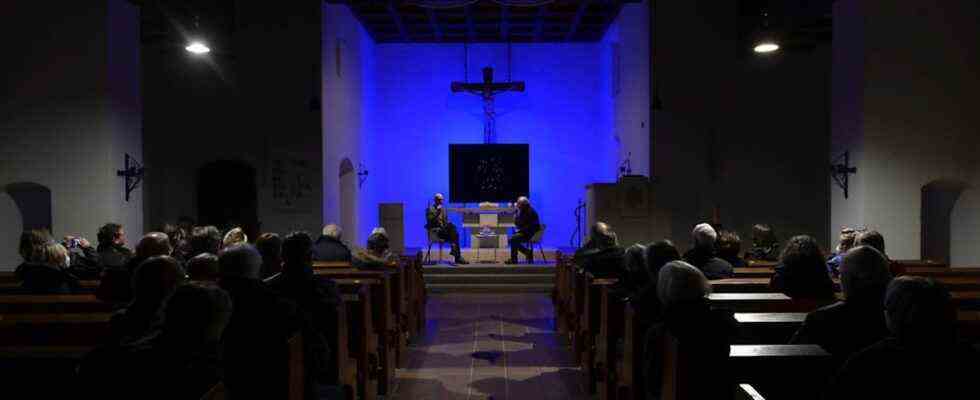“Hope. Life. Light!” is the name of the art campaign of the Evangelical-Lutheran Heilandskirche Unterhaching, which is showing two kinetic light installations by Hans Schork until February 27th. You can linger in front of them and, as Father Fabian Ludwig hopes, you will find the Christmas light that still shines for and in everyone. At the opening prayer for Candlemas on Wednesday evening, the artist revealed how he came up with these art objects and what he associates with them.
With Schork, points of light move on a black surface. You can “look at them, calm down, dream and fantasize,” said the artist, a doyen in the field of kinetic art, in conversation with Pastor Ludwig. The 86-year-old Schork is concerned with the constructive, less with religious aspects, but his “Great Meditation – Blue” (1995, 140 by 190 centimeters), which stands behind the altar, and his “Wolof Rot” (2002, 86 times 100 times 10 centimetres) in the church room many thoughts. During the prayer, the music of the Nova vocal ensemble was an additional source of inspiration, and recordings by the Swedish pianist Martin Tingvall are to be heard by the end of February.
With the “Meditation – Blue” white points of light appear as a circle. But the dots move and the circle slowly but steadily changes shape. Sometimes an oval tail moves through the picture, then a round point of light slowly falls down, just like a snowflake. The play of lights catches the eye, but at the same time it has a decelerating effect.
The installation “Wolof Rot” is set up in the church room.
(Photo: Claus Schunk)
As early as 1997 the “Big Meditation – Blue” was exhibited in the church in Bassano di Tevere in Italy and in 2003 with two side panels as a triptych in the St. Petri Church in Lübeck. There, as here, “Wolof Rot” formed an active contrast. Back then, Schork wanted to create an object with three motors, “something hectic,” he says. In fact, in “Wolof”, named after the language and largest ethnic group in Senegal, the points of light move much faster, rapidly changing their shapes and at times reminiscent of abstract objects. Schork emphasizes that he doesn’t know what the viewer is experiencing, but he also finds the red to be bloody and aggressive.
Even as a small boy he drew “labyrinth drawings” in the sand in front of the cattle loading station in Aschaffenburg and wanted to be able to paint like Rembrandt. Working as a surveyor, he recognized movement as he moved photo negatives around on the light table. In 1966, at the Venice Biennale, he became enthusiastic about the Argentine light artist Julio Le Parc: “The fact that you can paint without color fascinated me,” says Schork. A year later he built his first light-kinetic object “Begin as it began” with acrylic glass, fluorescent tubes and an electric motor.
He doesn’t need any more material today either: based on a sketch with lines and dots, he screen-prints two black stencils on Plexiglas. Where lights and dots are supposed to move, the plexiglass is left untreated. The front pane is fixed, the rear pane rotates slowly. Schock attaches fluorescent tubes to the frame behind the panes to create the desired background color. In the great meditation he had even wrapped several layers of foil around the fluorescent tube until he found the right blue. Still hold the foil, said the artist, smiling towards the audience.
The exhibition “Hope. Life. Light!” with light-kinetic objects by Hans Schork in the Heilandskirche Unterhaching, Liebigstrasse 22, is open daily from 8 a.m. to 8 p.m. It ends on Sunday, February 27, with a “Finissage Service” (starting at 10 a.m.).

